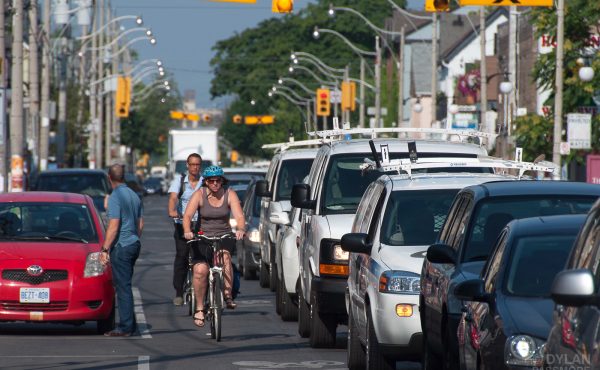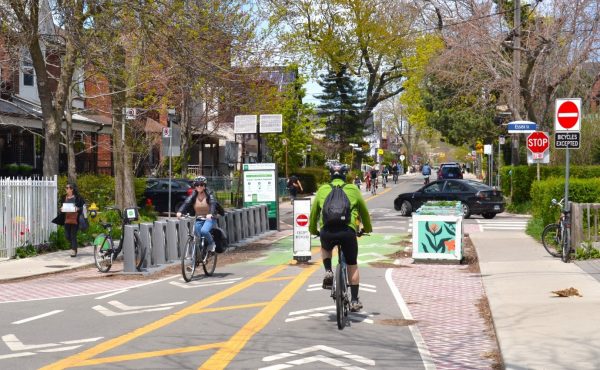
I just returned from a week in Sweden and was quite taken by the country’s advanced urbanity. I have a couple posts to make about my trip with some general observations and a few photos (thank you Bouke Salverda for your camera!). There are a few similarities between Toronto and Stockholm, most notably being the temperature and terrain. The place has been around for awhile (mid 1200s) so we could learn a thing or two from them.
Seeing as bike racks have been a news item in Toronto over the past week, I may as well as start with some examples from Stockholm. From what I could see, most racks were painted black and made of thick metal, but varied in shape and size. It seemed like the City got to pick from a few options, with the choice being a rack that fit the local surroundings or space requirements.

Stockholm also used a slight variation of Toronto’s ring and post racks. I looked at a few bikes locked up and tried to imagine if a two-by-four could fit in between the bars — I guessed it couldn’t, but I’m only 75% confident with my assumption. But since the “ring” was welded on to the main post, the rack would be really solid, making my two-by-four concerns moot. Correct me if I’m wrong. Also, the U-shaped racks (photo below) were popular throughout the city.


There were a few types of bike lanes is use through the city. In many parts, the lanes were completely separate from road traffic. Bike parking islands were often used to separate vehicular traffic from a bike lane. But drivers who feel the need to park their cars wherever they please is not just a North American problem, as seen above.

The above photo is a lane with a three-inch curb on its left side. The lanes are no wider than the ones here in Toronto, but the definitive nature of the lane shows a respect for the space that cyclists need when coming into close contact with vehicles.

Toronto now has two cyclist-only traffic signals — one at Bloor and Christie Pits and another at Cherry and Commissioners when the Martin Goodman Trail intersects with roads. On the Sodermalm island of Stockholm, Every major intersection with a separate bike lane had their own signaling system. Note the little blue cycling symbol atop the light standard.

I was also impressed with Stockholm’s bike lane signage. These signs, on the Soldermalm island were placed at the side of lanes and indicate to cyclists how far it is to the other neighbourhoods. Something like could be implemented in Toronto to point riders in the direction of other bike lanes, for example. It would be much easier to understand than the oddly numbered lanes the City is currently using.




5 comments
Stockholm is also the sponsor of perhaps the most gloriously demented tourism ad / viral video I’ve ever seen:
http://www.stockholmthemusical.com/
With thanks to Alison for sending me the link
I always really liked the idea of raised pavement for bike lanes. It defines a real space for cyclists, just as sidewalks do for pedestrians, instead of being a simple painted box … which tends to say “imaginary.” I believe that kind of statement would speak to drivers, who would then treat cyclists with more respect, as vehicles sharing the road rather than pesky nuisances. I would certainly bike more often if Toronto implemented them.
I noticed also in Portland Oregon they have those directional bike signs.
I think the point about all the different types of bike racks in Sweden is useful to Toronto as a lesson about the dangers of “monocultures”.
Having the same type of post and ring post everywhere here exposes Toronto to dutch-elm like diseases. When something comes along (like 2 X 4’s) that is a threat to post and rings ant that they can’t beat they’re all in danger of dying/being replaced.
That’s why it’s important to have a “variety” of options in place.
I’d support Toronto trying out some different options in addition to post and rings rather than just having one standard solution they use over and over again.
Easy for administration but not so good for the actual place.
– Dabusan
I like the upside-down U shaped racks quite a bit.
There are lots of variations of the ring and post – good to see this one in Sweden.